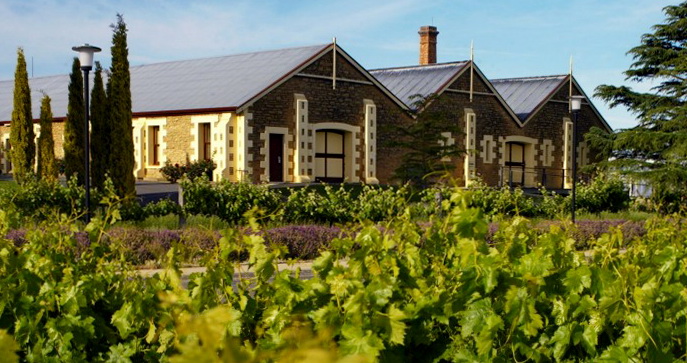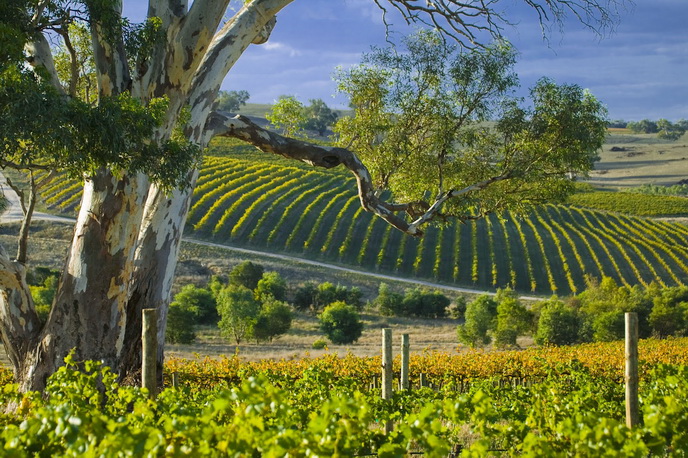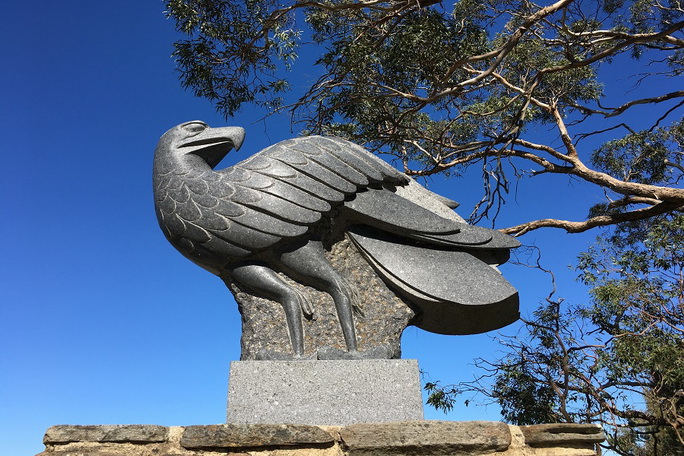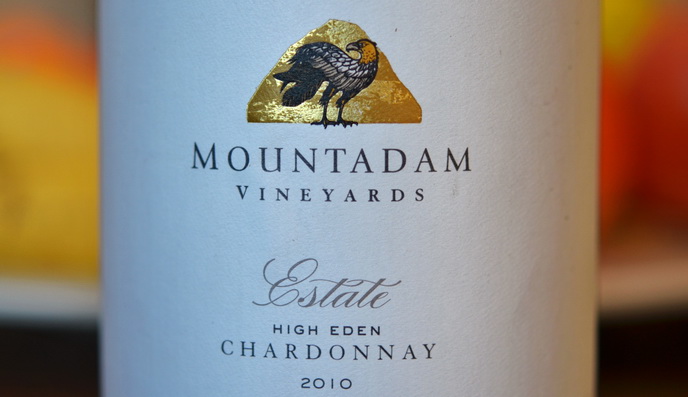Mountadam should be up there on Mount Olympus with Henschke, Grosset and the rest, and I don’t know why it isn’t. Now that Phil Lehmann is chief winemaker, that may change unless the current owners do silly things.
It was the vision of David Wynn that created Mountadam, after he’d created one of Australia’s greatest labels: Wynn’s Coonawarra Estate. He bought the run-down Chateau Comaum winery in 1951 against the wishes of his father Samuel, who’d built a wine business from the humble beginnings of a wine bar in Melbourne.

Quite a family, those Wynns. People thought David was crazy, rebuilding a winery in what was then a remote, cold and barren outpost on the way to Mount Gambier, at a time when Australians drank Sherry and Barossa Pearl. David also did a lot to make flagons of table wine popular, and perfected the wine cask. If only our politicians showed a glimmer of that kind of vision.
In 1970, David decided to go public and list Wynns on the stock exchange. Two years later, Allied Vintners of the UK acquired the business, along with Seaview in McLaren Vale. Following many years of upheaval in the wine business down under, Wynns ended up in the Southcorp stable alongside Penfolds and is now part of Treasury Wine Estates.
David’s next move was to plant a Chardonnay vineyard at the highest point in the Eden Valley, which isn’t a valley at all but a range of hills above the Barossa Valley. Once again, David played the pioneer, selecting a cool climate region that only had a few Riesling growers but no wineries, and planted 24 hectares to a brand new grape variety. The first Chardonnays down under were made by Tyrrells in the Hunter and Craignoor in Mudgee at around that time.
Cool climate viticulture was a new concept in those days: Andrew Pirie planted his first vines in the Tamar Valley at the same time as David Wynn planted Mountadam in the High Eden. Meanwhile, David’s son Adam studied Agricultural Science at the University of Adelaide, then went to the University of Bordeaux to complete a graduate degree in oenology (where he topped his class), and then worked in Burgundy to polish his practical skills.
The winery was named after Adam, against his wishes, according to the Japan Times. He said: ‘ … with a sister named Eva and a location in the Eden Valley, it was all quite biblical.’ On the ground, the Wynns had more fundamental challenges: At the time, there were hardly any Chardonnay vines in Australia, and you couldn’t buy French oak barrels down under so they had to import them directly.

Once again David Wynn showed that he was far ahead of his time: he discovered Chardonnay vines at ‘Marble Hill’ in the Adelaide Hills, at the South Australian Governor’s summer residence. The vines had been brought there from Burgundy in the 1860s. David took some cuttings from Marble Hill and propagated more vines at a nursery in Adelaide. More Here.
Today the Marble Hill clone is unique to Mountadam since the Marble Hill property was destroyed by fire and the original vineyards in Burgundy were wiped out by phylloxera. The story also goes that David Wynn never shared any cuttings of this clone with other winemakers (as is the custom). ‘I suspect David Wynn deliberately kept it as a secret ingredient,’ winemaker Con Moshos told Jeni Port in 2008.
Adam Wynn made the wines from 1982 onwards. He said it took until 1979 before they picked the first grapes, because the weather was harsh and the soil was harsher. The first commercial quantities were picked in 1984. Chardonnay was still a novelty then, and good Chardonnay rare as hen’s teeth. The style was still evolving down under. Mountadam Chardonnay was like a young Burgundy, oak dominating the fruit. Chunky almost. I bought most vintages over the years, and they’d take years to come good, 6 – 10 years just like white Burgundies. They were big and complex and creamy. Great food wines.
David Wynn died in 1995, and Adam sold the winery in 2000 to Cape Mentelle, which had become part of the French Luis Vuitton Moet Hennessy group. I asked Adam why he sold the vineyard. He said, ‘There were more and more doctors planting vineyards everywhere, it was hundreds in the eighties, now it was thousands. There were still only 100 or so real wineries operating, and about 15% of those were profitable.’ He laughed as he added, ‘and LVMH made me an offer that was hard to resist.’
After a fairly ordinary 6-year run, Adelaide businessman David Brown brought Mountadam back into Australian hands. According to Adam, LVMH had worked out that they made more profit from a handbag than a case of Moet, so they sold off some of their wine interests. David Brown owned sizable vineyards in Padthaway, so he was no stranger to the industry. In 2008 he persuaded Petaluma winemaker Con Moshos to move to Mountadam, and Con made some great Chardonnays such as the 2010 which we tasted a few weeks ago along with a Giaconda from the same year.
In late 2015 the Browns acquired the High Eden vineyard established by David Wynn in the early days and later sold along with Wynns Coonawarra. The two vineyards are now dissected by High Eden road, Mountadam on one side, High Eden on the other. Adam Wynn said varieties such as Gewürztraminer would have come from the High Eden Vineyard. High Eden was recognised as a sub-region of Eden Valley in 2001. It is an area of 40 square kilometers in the highest part of Eden Valley, which reaches 550 meters above sea level.
In 2014, Con Moshos left Mountadam and went back to work with his old boss Brian Croser at Tapanapa, after Croser bought back the old Petaluma winery in the Adelaide Hills. Consulting winemaker Tash Mooney filled in at Mountadam until the Browns found a new winemaker in Helen McCarthy who ‘d made wine at Thorn-Clarke and Taylors before that. Helen is not well-known but highly regarded.
She has a big job in front of her. Other varieties were planted at Mountadam over the years, including Riesling, Shiraz and Cabernet. The Chardonnay and Riesling vines are over 40 years old, the soils are quartz-rich sandy loams formed from the underlying schist bedrock, the property is close to the historic Boehm Springs Reserve that is a nesting ground for Wedge Tail Eagles – the bird on the Mountadam logo.

David and Jenni Brown have quietly built Mountadam into a sizable operation with 80 ha of vineyards. From a single wine, the range has expanded to a dozen. I said earlier that Mountadam should be up there with the best, and perhaps Helen McCarthy will help the winery take up its rightful place. Meanwhile it’s us drinkers who benefit from great wines at bargain prices.
And what is Adam Wynn up to these days? He developed a great love for Japan, he says, in part because his wife is Japanese and in part because his father David fell in love with Japan on his early business trips when promoting his wines. Adam became deputy chairman of the Australia-Japan Foundation some years ago, and also became the Honorary Consul General of Japan in Adelaide. In 2016 he was awarded the Order of the Rising Sun (Gold Rays with Neck Ribbon), the third highest order bestowed by the Japanese government. The award is a royal decree, much like our New Years honours and knighthoods. Adam now spends 6 months a year in Australia and 6 in Japan.
THE WINES
Mountadam Eden Valley Riesling 2016 – $19 at Kemenys. Made from 50-year-old vines. Classic Eden Valley Riesling serving up limes and talc and minerals; the fruit is intense, the acid a fine line and the length exemplary. Finesse and power in perfect balance. 13%. 94 points.
Mountadam Eden Valley Riesling 2017 – $23 at Nicks. The aromatics fairly leap out of the glass, followed by a burst of ripe limes and wildflowers, a dusting of talc powder and a sprinkle of minerals. The finest line of crisp acid completes a Riesling that is among the top handful from this vintage. 95 points.
Mount Adam Eden Valley Gewürztraminer 2016 – $24 at Kemenys. I bought a box of this on spec but was underwhelmed by the first bottle. Another one opened a couple of weeks ago showed the wine coming out of its shell – there’s a lot of restraint and finesse here, and great length, it just needs a bit more time for the peacock’s tail to show its magic. 94+ points.
Mountadam Eden Valley Pinot Gris 2016 – $19 at Kemenys. This is a new variety for this winery, and I haven’t tasted it yet. Halliday says: ‘The climate endows the wine with drive and intensity, giving it stature, and forcing me to sew my lips together so I won’t dismiss all pinot gris out of hand. And it is pear, apple and citrus-driven, not by residual sugar. Alcohol: 13%. Drink to: 2020. 94 points.’
Mountadam Barossa Chardonnay 2015 – $15 at Winestar. Mountadam is still about Chardonnay, first and foremost. They used to buy in Barossa fruit for this label to make an easy-drinking, unoaked Chardonnay. The 2015 is a great example of the style: rich and round and great drinking now. 92 points.
Please Note: For 2016 the label has changed to Fifty Fifty, and is made from fruit grown at Mountadam. A Shiraz and a Cabernet are also made under this new label.
1960 Mountadam Old Vine Ridge Block Chardonnay 2015 – $19.60 at Kemenys. Rich, round and hard to put down, this is a gorgeous mouthful of classic peaches and cashews chardy. A great interpretation of the old style without the buttery excess. 95 points. Bargain

Mountadam High Eden Chardonnay 2016 -$27 at Winesellersdirect. After a soft and simple 2015, the 2016 is back to classic peaches and cream, cashew nuts and spicy notes from the French oak. Barrel fermentation has added texture and complexity. Built for the long haul. (these are first impressions from tasting the wine in a big line-up so I can’t score it yet).
Mountadam Marble Hill Chardonnay 2015 – $65 at No Frills. The top Chardonnay made at Mountadam, from a single block. I haven’t come across it, or any reviews for it.
Mountadam Eden Valley Cabernet Sauvignon 2015 – $20 at MyCellars, where the freight is free for subscribers on any quantity (promo code BWU20). The reviews are all over the shop for this red, with 89 points from Huon Hooke and 91 from the Winefront. For once, I’m with James Halliday who calls this red ‘another example of Helen McCarthy’s skills as a winemaker, sculpting a cabernet with razor-sharp varietal definition, and also managing to provide textual complexity going beyond the tannins that are part and parcel of the variety.’ This sumptuous red surprised me until I saw that Helen McCarthy used to make those rich, plush reds at Thorn-Clarke. 93+ points (JH 95).
Mountadam Eden Valley Shiraz 2015 – $23 at Nicks. I don’t know this wine, but James Halliday likes it for 95 points and talks about pepper and spice and ‘delicious black cherry fruit … This is very good Eden Valley Shiraz.’
Mountadam the Red 2010 – $35 at Kemenys. A Bordeaux blend of the best reds from the estate, 52/45/3% Cabernet Sauvignon, Merlot and Cabernet Franc. I haven’t tried this wine; James H. says ‘the palate [is] a lovely display of satin and velvet blackcurrant and redcurrant fruit, holding its line after 2 years in new French oak, perfectly weighted tannins the cream on the cake. 14.5%. Drink by: 2030. 96 points.
Mountadam High Eden Pinot Chardonnay NV – $20 at Winestar. I had no idea that they made a bubbly here, but there it is. Bubbles guru Tyson Stelzer gives it 92 points; check the review at the link.
Kim
